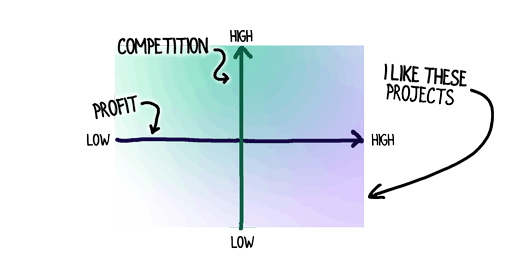Some consulting opportunities are rotten. Blech. Don’t want ‘em.
Leave ‘em, don’t look back, and set your sights on better projects for your consulting firm.
But hold on, Harry. (Wait, Walter? Pause, Paula?)
A few of those stinky projects may actually be goldmines.

A quick story:
This past June, my wife and I were driving to a remote Portuguese town, when a landfill appeared on the horizon.
Even from a distance, it was easy to recognize the manmade hill; trailer-sized blocks of compacted, brown and white trash, stacked and tumbled into disorganized heaps like some giant toddler’s Lego pile.
Our car windows were down to enjoy the temperate air, and my wife was dozing in the passenger seat. Since the only alternate routes involved goat paths, I faced a dilemma:
Should I wake my wife up by closing the car windows, and alert her to the unpleasant landmark ahead, or should I hope that the smell would be tolerable while we drove by, leaving her asleep and unaware?

I chose to wake her. (After all, travel is about sharing the adventure.) But, the potential stain on our mental travelogues never materialized, because the trash heaps turned out to be…
Marble.
Gorgeous, 15-ton slabs of Portuguese marble excavated from one of the world’s premier quarries. So much marble, that enormous slabs were strewn about and piled into landfill-shaped hillocks.
Nearby, in Estremoz (pronounced the way Sean Connery would say “stray moss”), we admired, and purchased, stunning art sculpted from blocks of the local stone.
Which brings us back to the starting question:
Are the consulting opportunities you’re avoiding, fetid trash heaps or dazzling sculptures hidden in landfill clothing?
Your goal is easy: unearth great projects that other consulting firms decline.
A few guidelines may help you distinguish diamonds from dross, and rubies from rubbish.
When Garbage is Garbage
Too Small
Your consulting firm should have a minimum acceptable project size, below which you reject opportunities. Although small projects can sometimes be a gateway to larger engagements, more often they are low-return, resource drains.
Low Margin
Similarly, skip unprofitable projects. This sounds obvious, of course; however, I’m amazed at how many consulting firms accept unalluring projects that deliver minuscule or negative margin for their firm.
Strategic Distraction
Flee from projects that appear unattractive and also would jerk you far away from your target market or core offering.
Unpleasant Client
There’s no reason to accept consulting projects from clients who are ill-mannered, inconsiderate, rude, or don’t pay on time. Leave those ugly opportunities behind.

When Garbage is Gold
Unsexy
Many consulting firms walk away when the industry, problem or client are decidedly not sexy.
Hordes of consulting firms want to pursue silicon valley clients while turning their nose up at rust-belt opportunities.
That’s a mistake. Plain-Jane, out-of-favor industries and problems may offer consulting opportunities that generously stimulate your consulting mind and pocketbook.
Small Client
Working with Fortune 500 clients is like a badge of honor for many consultants. They scoff at the idea of working with tiny companies.
Good. Let them scoff while you gobble up the many, lucrative consulting projects offered by pint-sized organizations.
If your minimum consulting project size is $10 million, then you need to fix your target firmly on huge companies. However, if your minimum project is $100,000 (or less), then there are plenty of obscure clients who could hire you.
Difficult to Service
Consulting prospects may be difficult to serve because they are geographically remote, demand significant hand-holding, or require complex (and expensive) project management.
As long as you price your consulting projects correctly, these opportunities are outstanding for your firm. They force you to upgrade your systems, processes and client experience.
Other consulting firms look at these opportunities as money-losing nightmares. For your consulting firm, they can be an opportunity to shine while improving the effectiveness and efficiency you’ll apply across your client portfolio.
How else do you identify outstanding consulting opportunities that other consulting firms miss?
Text and images are © 2024 David A. Fields, all rights reserved.

 David A. Fields Consulting Group
David A. Fields Consulting Group 

Hi David,
I just read your book and had to join your email list. Your insights and the way you reframe consulting challenges is so helpful.
Referrals from clients, and even fellow board members, have been a very helpful pathway to finding diamond-in-the-rough opportunities. Doors have opened to industries I hadn’t considered.
Thanks for the value you bring!
Lisa Avedon
Great idea, Lisa. The source of a project is an excellent indicator of quality. If a trusted contact suggests an opportunity that, on the surface is unattractive, it’s worth a second look.
(Thank you also for the kind words, Lisa. Feedback is always appreciated.)
Love the analogy and the message – thanks David!
Just sad we didn’t get to see the sculpture!
You’re welcome, Steve. I appreciate you being part of the community and giving your feedback.
(Sorry about the marble craftsmanship–sometimes, stick figure scribbling isn’t up to the task.)
“Working with Fortune 500 clients is like a badge of honor for many consultants. They scoff at the idea of working with tiny companies. Good. Let them scoff while you gobble up the many, lucrative consulting projects offered by pint-sized organizations.”
Good insight, David. People remain attracted to brand names even when they provide far less value for the dollar. Why? Prestige. In other words, name-dropping ability. Which offers more value: a Hyundai Tuscon or a BMW X3? Both are great vehicles, but one is nearly twice the price. To each his own.
Great example, Jonathan. Some people like to pad their egos. I prefer to pad my wallet!
David
I agree. Working with big Corporates can be a nightmare. I had a huge amount of work with GE in Europe and then worked with them in the US (20 years ago) . They contained the daily rate to $900 per day when I was charging much more in Europe. They stated that it was a privilege to work with them and I could leverage my time with potential clients. I moved on because they broached my personal boundaries re discounted fees. The lesson here is to focus on personal consultancy boundaries and stick to them. I have been burned many times by doing things for free or a big discount on normal rates. Decide on boundaries and stick with them.
Every consultant would be wise to heed your words, Philip. Deciding on your firm’s Rules of Engagement, then sticking with them, will set you up for a happier, more successful life in consulting. (In fact, look for an article on this point soon.)
Large, corporate clients come with a host of problems, including arrogance as shown in your example. There’s also the tendency for big companies to contract consulting poorly, to insist on day rates, to demand miserly terms (e.g., 90-day net payment), and to insist on onerous contract requirements. For some projects and consulting firms, it’s worth the hassle. For many, it’s not.
Your illustrative example is a valuable addition to the conversation, Philip.